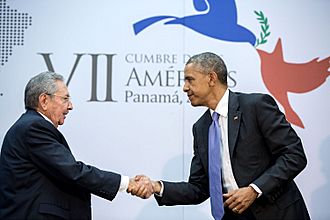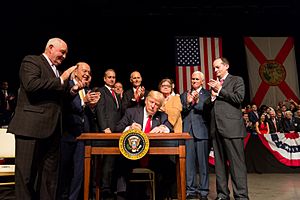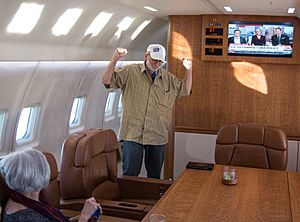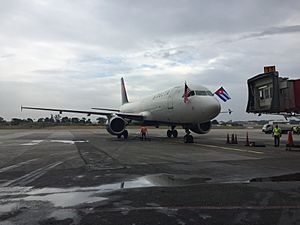Cuban thaw facts for kids

U.S. President Obama meets with Cuban leader Raúl Castro in Panama.
|
|
| Date | July 20, 2015 – June 16, 2017 |
|---|---|
| Also known as | Normalization of relations between the governments of Cuba and the United States |
| Patron(s) | Pope Francis |
| Organized by | President of the United States Barack Obama, President of the State Council of Cuba and First Secretary of the Communist Party Raúl Castro, Prime Minister of Canada Stephen Harper, Pope Francis, Holy See |
| Participants | |
| Outcome | Brief restoration of diplomatic relations between the two governments |
The Cuban thaw (which means "Cuban melting" in Spanish) was a time when Cuba and the United States started to become friends again. This change began in December 2014 and ended over 50 years of bad feelings between the two countries.
In March 2016, Barack Obama became the first U.S. president to visit Cuba since Calvin Coolidge in 1928. This was a big step!
The idea to make relations better was talked about secretly for months. Pope Francis and the Government of Canada helped a lot with these secret meetings. The plan included letting more Americans travel to Cuba and making it easier to send money there. U.S. banks could also start working with Cuba's money system. Most importantly, the U.S. embassy in Havana and the Cuban embassy in Washington reopened. These embassies had been closed since 1961, after Cuba became close with the USSR (Soviet Union).
On April 14, 2015, the U.S. said it would take Cuba off its list of countries that support terrorism. This happened officially on May 29, 2015. This showed that the U.S. was moving away from its old Cold War conflicts with Cuba. On July 20, 2015, the "interests sections" (which were like small embassies) in Washington and Havana became full embassies again.
However, things changed again. On June 16, 2017, President Donald Trump said he was "canceling" many of Obama's deals with Cuba. He said new rules would be made. By November 2017, some travel rules were made stricter again. Also, new limits were placed on money dealings with businesses linked to the Cuban armed forces. Even though some changes were made in 2019, many of the improvements from 2015 are still in place.
In 2022, the Biden administration announced new changes. These changes reversed some of Trump's rules. For example, limits on money sent to families were removed. Also, more staff were added to the Havana embassy to help process visas.
Contents
Prisoner Exchange: A New Start
In 2012, Cuba suggested a "spy swap." They wanted the remaining three members of a group called the Cuban Five to be sent back to Cuba. These Cubans had been in U.S. prisons since the 1990s for spying. In return, Cuba would release Alan Gross, an American who had been jailed in Cuba. Gross was imprisoned for giving special phone chips and internet equipment to Cuba's Jewish community.
At first, the U.S. said no. But in December 2014, the prisoner swap finally happened. This was right after President Obama announced plans to improve relations. Besides Gross, the swap also included Rolando Sarraff Trujillo. He was a Cuban who had worked for American intelligence and had been in a Cuban prison for almost 20 years. After this, Cuba also released 53 political prisoners, as the U.S. had asked. All of them were free by January 12, 2015.
This prisoner swap was the biggest change in U.S. policy towards Cuba since the U.S. stopped most trade with Cuba in 1962. It removed a major problem between the two countries. Alan Gross has since become a strong supporter of better relations with Cuba.
Easier Travel and Trade
The U.S. trade embargo (a ban on trade) with Cuba can only be fully ended by the U.S. Congress. However, the Obama administration used its power to make some travel rules easier for U.S. citizens. They also eased some rules on buying and selling goods between the two countries. President Obama asked Congress to lift the embargo in his speeches in 2015 and 2016.
Many American artists and sports teams visited Cuba. In February 2015, Conan O'Brien became one of the first American TV personalities to film in Cuba in over 50 years. The Minnesota Orchestra played concerts in Havana in May 2015, being the first U.S. orchestra to play there since 1999.
Major League Baseball (MLB) also got involved. In March 2016, the Tampa Bay Rays played a baseball game against the Cuban national team in Havana. Presidents Obama and Castro both watched the game.
Travel options expanded too. Sun Country Airlines started charter flights between New York and Havana in March 2015. The U.S. also allowed ferry services to start between Miami and Cuba. In March 2016, Carnival Cruise Line got permission to sail from Miami to Havana. At first, Cuba didn't allow Cuban-born people to return by sea. But after protests, Cuba changed its rule, and the first Carnival cruise sailed on May 1, 2016.
Between January and May 2015, 36% more Americans with no family ties in Cuba visited the island compared to the year before. Also, many more Cubans came to the U.S. in 2015 than in 2014.
Making Relations Normal
Some say the "Cuban thaw" happened because Venezuela, Cuba's main international partner, was having money problems. Venezuela used to give a lot of support to Cuba. But when oil prices dropped, they couldn't afford to help as much.
Discussions Between Countries
On January 21, 2015, the U.S. and Cuba started talks in Havana to discuss how to make relations even better. The U.S. team was led by Roberta S. Jacobson, and Cuba's team by Josefina Vidal Ferreiro. They talked about rules for people moving between the two countries. Cuba wanted the U.S. to end its special immigration rule for Cubans. This rule, called the "wet feet, dry feet policy," allowed Cubans who reached U.S. soil to become residents.
The U.S. side made it clear that improving human rights in Cuba, like freedom of speech, was very important. The U.S. also said it would keep its current immigration policy for Cubans.
More talks happened in Washington, D.C., in February 2015. Both sides said the talks were good. However, Cuba being on the U.S. list of "state sponsors of terrorism" was still a big problem.
A third round of talks took place in Havana in March 2015. Later, Obama and Castro met at the Summit of the Americas in Panama in April. Castro praised Obama and said he was sorry for blaming the U.S. government for the ongoing embargo. Both leaders said they looked forward to more direct talks.
The Vatican and Pope Francis played a very important role in helping the U.S. and Cuba talk to each other. The Catholic Church has always had a good relationship with Cuba, even after the Cuban Revolution in 1959.
Removing Cuba from the Terrorism List
Cuba said that for relations to truly improve, it needed to be removed from the U.S. list of "state sponsors of terrorism." Cuba was one of only four countries on this list. The U.S. government began looking into whether Cuba should still be on it.
On April 14, 2015, President Obama told the U.S. Congress that he decided to remove Cuba from the list. He said Cuba had not supported international terrorism for the past six months and promised not to in the future. Congress had 45 days to block this, but they didn't. So, Cuba was officially removed from the list on May 29, 2015.
Cuban Bank Account in the U.S.
On May 20, 2015, the Cuban government opened a bank account in the United States. This allowed Cuba to do business in the U.S. without using cash for the first time since the embargo began.
Embassies Reopen

Cuba and the United States officially started full diplomatic relations again at midnight on July 20, 2015. The "interests sections" in Washington, D.C., and Havana became full embassies. A ceremony was held at the Cuban Embassy to raise the flag of Cuba. U.S. Secretary of State John Kerry and Cuban Foreign Minister Bruno Rodríguez Parrilla spoke to the press. They talked about the big step forward but also the differences that still remained. Kerry later flew to Cuba to raise the flag of the United States over the U.S. Embassy in Havana.
U.S. Economic Plans
The U.S. government had specific goals for improving trade with Cuba. American diplomat Roberta S. Jacobson suggested improving Internet access and cell phone service in Cuba. This would help Cuba connect more with the world economy. This opened a new market for American phone companies like Verizon and Sprint. By July 2016, companies like Airbnb and Netflix were also working in Cuba.
The U.S. wanted to increase money from tourism in Cuba. By lifting travel rules, Americans could visit and buy American goods in Cuba. In March 2016, Starwood became the first U.S. company to sign a deal with Cuba since the 1959 revolution. They agreed to manage two hotels in Havana. Many American companies and groups like Engage Cuba supported closer economic ties with Cuba.
Mail and Airline Services Return
On December 11, 2015, the U.S. and Cuba agreed to bring back postal service between the two countries. This was the first time since 1963. A week later, on December 17, 2015, they agreed to restart regular flights. This was the first time since the Cuban Missile Crisis. This agreement allowed for 110 flights a day and started on February 16, 2016. Mail service officially resumed on March 17, 2016.
In July 2016, eight U.S. airlines were approved to fly to Cuba. Flights began as early as September. On August 31, 2016, JetBlue became the first U.S. commercial airline in over 50 years to land a plane with U.S. passengers in Cuba. More flights followed, and on November 28, 2016, JetBlue and American Airlines planes landed in Havana. This was a historic moment, as it was the first time in over 50 years that a U.S. commercial flight landed in the capital city.
However, by November 2017, some airlines stopped flying to Cuba.
U.S. President Visits Cuba
President Obama arrived in Cuba for a three-day visit on March 20, 2016. He led a large group of people, including business leaders and members of Congress. Obama was the first sitting U.S. president to visit Cuba since Calvin Coolidge in 1928.
Obama had said he would only visit Cuba if he could meet with Cuban people who disagreed with the government. He made it clear to Cuban leader Raúl Castro that he wanted to talk to everyone who wanted more freedom of speech in Cuba.
Travel by Sea Resumes
On April 22, 2016, rules for U.S. commercial ships traveling to Cuba were lifted. This meant that the Carnival Cruise Line could now travel there.
On May 1, 2016, the MV Adonia, a cruise ship from Carnival, left Miami and docked in Havana Bay. This was the first time in almost 40 years that a U.S. passenger ship sailed from the U.S. to Cuba. Carnival planned for the Adonia to go from Miami to Havana every other week.
Other cruise lines like Royal Caribbean and Norwegian Cruise Line also wanted to offer cruises to Cuba. Several Florida ferry companies also got permission from the U.S. government to start service to Cuba. However, they were waiting for Cuba's permission.
In June 2019, the Trump administration changed this policy and banned cruise ship travel to Cuba.
What People Thought
In Cuba
Raúl Castro, the leader of Cuba's Communist Party, had said in 2013 that a slow change of leadership was happening. He also said he would not run for re-election in 2018. When the agreement with the U.S. was announced in December 2014, Castro spoke about the benefits of better relations, like ending the U.S. embargo.
Fidel Castro, Raúl's brother and the former leader, seemed to welcome the thaw at first. In January 2015, he wrote that he didn't trust U.S. policies but would always support cooperation and friendship. However, in 2016, Fidel Castro criticized Obama after his visit to Cuba. He wrote a strong letter saying Cuba didn't need the U.S. to give them anything.
In December 2014, Raúl Castro publicly thanked Pope Francis and the Catholic Church for their help in the secret talks. Church officials in Cuba said that plans to build new Catholic churches, which had been stopped since 1959, were now being processed. The first new church since 1959 was planned for Sandino.
In the United States
The "Cuban thaw" received mixed reactions from politicians in the United States. Senator Marco Rubio from Florida, a Cuban-American Republican, was a strong critic. He said that recognizing Cuba's government would give it power it didn't deserve.
Senator Bob Menendez, a Democrat from New Jersey, also criticized Obama's decision. He said Obama had "wrongly rewarded a totalitarian regime." Other Democrats also spoke out against the change.
However, some Republicans supported the thaw. Senator Jeff Flake of Arizona believed many members of Congress would eventually agree with the new policy. Senator Rand Paul of Kentucky also supported it, saying that the 50-year embargo "just hasn't worked."
Hillary Clinton, who was Obama's Secretary of State and a presidential candidate, strongly supported the decision. She argued that the embargo had actually helped the Castro government by giving them someone to blame for Cuba's problems. She also said the embargo didn't help with freedom of speech or releasing political prisoners.
Public Opinion
A survey in January 2016 found that 63% of Americans approved of Obama's decision to restart diplomatic relations with Cuba. Only 28% disapproved. More Democrats and Independents supported it than Republicans. The study also found that 66% of Americans wanted to end the trade embargo against Cuba. Support for these changes was widespread among all age groups and backgrounds. However, younger Americans were more likely to support it. Even with this support, only 32% of Americans thought Cuba would become "more democratic" soon.
Global Reactions
Most countries around the world reacted very positively to the "Cuban thaw." Radio Poland reported that Poland's foreign ministry wanted the U.S. to go even further and lift the embargo completely.
China, a close ally of Cuba, also welcomed the new relations between Cuba and the United States.
Israel was one of the few countries that didn't immediately welcome the change. It was reported that Israel's Foreign Ministry was surprised. Relations between Cuba and Israel had been difficult since the 1960s. Israel had also been the only country to consistently side with the U.S. against United Nations resolutions criticizing the embargo.
Many leaders in Latin America were happy about the thaw. Venezuelan President Nicolás Maduro, who often criticized U.S. policy, called Obama's move a "valiant and historically necessary gesture." The President of UNASUR, Ernesto Samper, said it was "very good news, not only for Cuba but for the entire region." Juan Carlos Varela, the President of Panama, hoped it would lead to a "united region."
The Canadian government, which had always had better relations with Cuba than the U.S., also reacted positively. Canada's Foreign Minister John Baird suggested the policy change could help "transform" Cuba for the better.
Media Views
News sources quickly called the sudden change in relations the "Cuban thaw." They predicted it would bring many good social and economic benefits to both countries. Newsweek reported that the stock market went up when news of the thaw came out. Reuters said the thaw might make Cuba more likely to send back people wanted by U.S. officials. The Associated Press mentioned environmental concerns, as the thaw could lead to oil and gas drilling off Cuba's coast. Bloomberg News reported that the thaw would even help Major League Baseball by making it easier to sign Cuban players. There were also reports on how the thaw affected Cuban society, like its real estate market and more focus on learning English.
The New Republic called the Cuban thaw "Obama's finest foreign policy achievement." The Indonesian journal Strategic Review suggested Obama could follow the example of how his predecessor Bill Clinton improved relations with Vietnam.
Granma, Cuba's state newspaper, published many articles about the thaw. They said that "International public opinion supports removal of Cuba from U.S. list of state sponsors of terrorism." They also stated that Cuba "rejects and condemns all acts of terrorism."
After the Thaw
Trump Administration Changes

On June 16, 2017, President Donald Trump announced changes to Obama's policies on Cuba. He called Obama's actions "terrible and misguided." He banned American money from going to the Cuban military, especially to businesses they managed. This meant some hotels and tourist places were off-limits to Americans. He also stopped individual "people-to-people" travel to Cuba, but allowed organized "educational" groups and family visits to continue. Airline and cruise ship visits were still allowed, and embassies remained open. These new rules started on November 9, 2017.
On June 4, 2019, the Trump administration announced a full ban on cruise ship, private yacht, or plane travel to Cuba. They also banned "people-to-people" travel, which was a popular way for Americans to visit the island. Cuba's Foreign Minister, Bruno Rodríguez Parrilla, said Cuba "rejected" these new rules. He believed they were meant to hurt Cuba's economy and living standards to force political changes.
More changes were made in September 2019 regarding money sent to families.
Biden Administration Changes
The Biden administration at first continued the rules from the Trump administration. However, in May 2022, some of these rules were reversed. This included allowing more flights to Cuba and restarting a program to help families reunite.
See also
 In Spanish: Deshielo cubano para niños
In Spanish: Deshielo cubano para niños
- Khrushchev Thaw




